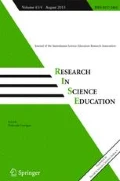Conclusion
The language used in the science education literature often serves the explicit function of presenting information and making cases but it also conveys implicit messages and points to links outside the technical framework of science education. The “pupil-as-scientist” metaphor is embedded in a rich network of associated ideas only some of which have been exploited in research in this and other areas.
Similar content being viewed by others
References
BLOUGH, G.O. (1960) Developing science programs for the elementary school. In N.B. Henry (ed.)Rethinking Science Education, 59th Yearbook of the National Society for the Study of Education, Chicago, N.S.S.E., pp. 112–135.
BRUNER, J. (1960)The Process of Education Cambridge, Mass., Harvard University Press.
DRIVER, R. (1983)The Pupil as Scientist?, Milton Keynes, Open University Press.
GILBERT, J.K., OSBORNE, R.J. & FENSHAM, P.J. (1982) Children's science and its consequences for teaching.Science Education, 66, 623–633.
GILBERT, J.K. & WATTS, D.M. (1983) Concepts, misconceptions and alternative conceptions: Changing perspectives in science education.Studies in Science Education, 10, 61–98.
GRUBER, H.E. (1974) Courage and cognitive growth in children and scientists. In M. Schwebel & J. Ralph (eds).Piaget in the Classroom, London, Routledge and Kegan Paul. pp. 73–105.
GRUBER, H.E. (1981)Darwin on Man: A Psychological Study of Scientific Creativity, Second edition, Chicago, University of Chicago Press.
HENRY, N.B. (ed.) (1947)Science Education in American Schools, 46th Yearbook of the National Society for the Study of Education, Part I, Chicago, N.S.E., p. 63.
MILLAR, R. & DRIVER, R. (1987) Beyond processes.Studies in Science Education, 14, 33–62.
NAY, M.A. & CROCKER, R.K. (1970) Science teaching and the affective attributes of scientists.Science Education, 54, 1, 59–67.
NEWMAN, B.C. (1978) The scientific status of any so called science.Research in Science Education, 8, 1–9.
OSBORNE, R. & FREYBERG, P. (1985).Learning in Science: The Implications of Children's Science, Auckland, Heinemann.
PIAGET, J. (1970)Science of Education and the Psychology of the Child, London, Longman.
POPE, M.L. (1982) Personal construction of formal knowledge.Interchange, 13 4, 3–14.
POPE, M.L. & GILBERT, J.K. (1983) Explanation and metaphor: Some empirical questions in science education.European Journal of Science Education, 5, 249–261.
POPE, M.L. & GILBERT, J.K. (1985) Theories of learning: Kelly. In R. Osborne & J. Gilbert (eds)Some Issues of Theory in Science Education, Hamilton, Science Education Research Unit, pp. 19–41.
SIMPSON, R.D. & ANDERSON, N.D. (1981)Science, Students and Schools, New York, Wiley.
STRIKE, K.A. & POSNER, G.J. (1985) A conceptual change view of learning and understanding. In L.H.T. West & A.L. Pines (eds)Cognitive Structure and Conceptual Change, Orlando, Academic Press, pp. 211–231.
Rights and permissions
About this article
Cite this article
Gauld, C. The “pupil-as-scientist” metaphor in science education. Research in Science Education 18, 35–41 (1988). https://doi.org/10.1007/BF02356578
Issue Date:
DOI: https://doi.org/10.1007/BF02356578



